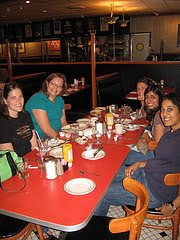 AS WE WORK TOWARD GREATER DIVERSITY ON OUR nonprofit boards, more and more boards are being made up of people who may not know one another well or at all. They don't run in the same social circles in the community, they may come from a wide geographic area or spend just a part of their time in one community. The result is they may only see one another at your organization.
AS WE WORK TOWARD GREATER DIVERSITY ON OUR nonprofit boards, more and more boards are being made up of people who may not know one another well or at all. They don't run in the same social circles in the community, they may come from a wide geographic area or spend just a part of their time in one community. The result is they may only see one another at your organization. Moving a group of relative strangers toward a cohesive team requires that each person shifts from an individual to a group mindset where the success of the whole is the goal. Successful teams care not only about the organization, but care enough about each other to ensure that everyone is able to meet their responsibilities. To get to that point, team members need to have opportunities to get to know one another just enough to foster mutual trust and respect. After all, it is just those two behaviors that get groups through stressful, even difficult, times.
So, how can board and staff leaders build cohesion within a board whose members scatter to the four winds after each board meeting, or at the least, have few points of intersection outside of the board room?
This question was posed recently to a board with just this kind of makeup. Here's what the group suggested for itself:
- Add breaks during board meetings where folks can mingle
- Offer dinner or cocktails after board meetings to enhance social interaction
- Meet over dinner or over lunch, again to interject a social element
- Meet more frequently? (for example, if your board meets six time a year, would eight times a year up the cohesion?)
- Lessen amount of information on agenda, therefore giving more time for discussion and breaks
- Relook at how committees are used (are task forces a better way to foster a greater variety of board member interactions?)
- More assigning of tasks from board discussions for members to work on together (again, a variety of interactions being the key)
The goal here is cohesion, not group-think. Opinion-sharing and healthy debate are key elements of board and organizational vitality. A cohesive group allows for and even embraces differences of opinion because underlying values about the organization's vision and mission are respected and shared.
Photo: Committee Meeting from voteprime


Comments
Nonprofit trends